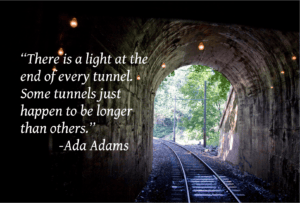In this article I share the story of how a strategy session went off track, even amongst CX experts, and an approach that works better.
“This photo of the London Tube Map is so cool.”
“It sure is, I think it would be a great guide to our work.”
“I think so too. We can design our strategy in a way that fits into the map.”
![]()
I had been invited to sit in with a group of CX experts to design a learning curriculum for CX practitioners.
And after the introductions, that’s almost word for word how the conversation amongst the experts had kicked off.
There had been an earlier meeting that I’d missed and it was during that earlier meeting that the group had landed on the map of the London Tube system.
And had chosen it as their North Star to design a CX learning curriculum
But this was the wrong starting point
By falling in love with a clever image – and I’m sure we’re all guilty of this at some point in our career – the entire project had been derailed.
Because rather than an open, structured and embracing approach to strategy, the discussions became tethered to whether they fit into the London Tube map – or not.
And those discussions were going to miss out on the questions that mattered more.
I teach a lot of CX and Customer Service strategy and here’s a better approach
I teach a lot of strategy in our various CX and Customer Service workshops and here’s some content that my Participants have told me helped.
This is wisdom from USAA, recognized as one of the world’s most Customer-focused organizations.
And it’s a company I have personal experience with as I’m the child of a military family and a USAA Member since the age of 16.
Greg Marion, the VP of Enterprise Strategy at USAA, shared that there are 4 parts to a business strategy:

His 4 elements are remarkably clear:
- What is our Vision?
- Who do we serve? (The Who)
- How will we serve them? (The How)
- How will we track our progress along the way? (The Metrics)
Of course there are lots of things going on within each element, but my intention here isn’t to dive down into a strategy workshop.
It’s to introduce a framework that ‘starts at the top’. Which is what I think the group of CX experts I was sitting with had not yet done.
So using the 4-element model I introduced a question – what’s the vision for the learning and development curriculum you’re putting together for the industry? If all your dreams come true what will that look like?
And before we get into the nitty gritties of courses and outlines, who do we serve? Who are we writing this curriculum for?
Ok – now we know what our vision is and we know who we’re serving. How will we serve them? What’s our product? What will the delivery or distribution mechanism be? Are we serving folks the way they want to be served?
And finally, how will we know we’re successful? Or that we’re on the right track and can adjust/readjust as needed? That’s where metrics come in.
I’m a big fan of determining the metrics up front before we start the initiative. Because then there’s real world alignment to our work. As well as accountability for our work.
This approach can help
Not only is this approach more structured. It’s more ‘outside-in’.
Because we’re looking out to who we’re serving, how we plan to serve them and metrics of success that keep us accountable and on track.
Or put another way, we discussed the problem we solve and how we’re going to solve it for real people in the real world.
Imagine how much differently the conversation would have gone if the group of CX experts had used a strategic framework to guide the development of the learning and development curriculum.
As compared to designing around a pretty picture.
Thank you for reading!
If you’d like to keep up with our articles and other information just leave your email address in our contact form or visit me on LinkedIn!
Daniel Ord
www.omnitouchinternational.com





 “We need to connect to our purpose and remember that CX = EX. Only then can our vision accelerate and digitalization will reinvent our core culture. Unleashed, ROI will rise up and create tangible benefits for all Stakeholders with less friction and more delight.”
“We need to connect to our purpose and remember that CX = EX. Only then can our vision accelerate and digitalization will reinvent our core culture. Unleashed, ROI will rise up and create tangible benefits for all Stakeholders with less friction and more delight.” My favourite Presenters, on any topic, share their experience on what worked and what didn’t work.
My favourite Presenters, on any topic, share their experience on what worked and what didn’t work.


 Practice doesn’t make perfect, it makes permanent.
Practice doesn’t make perfect, it makes permanent. Or perhaps they just don’t have the depth of their own that enables them to successfully grow other people.
Or perhaps they just don’t have the depth of their own that enables them to successfully grow other people. I regularly meet Contact Centre Leaders who are literally brand new to the industry.
I regularly meet Contact Centre Leaders who are literally brand new to the industry.





 Not the organizational vision though of course the CX Vision must map to the organizational vision.
Not the organizational vision though of course the CX Vision must map to the organizational vision. Equipped with my CX Vision (point #2) and my readiness analysis (point #3), I can now set out the short, mid & long term activities needed to move forward.
Equipped with my CX Vision (point #2) and my readiness analysis (point #3), I can now set out the short, mid & long term activities needed to move forward. I saw a CX Consultant once say, “It’s not about the money…”. And I remember thinking what terrible advice that was.
I saw a CX Consultant once say, “It’s not about the money…”. And I remember thinking what terrible advice that was. Metrics inform me of my progress – and keep our CX efforts headed in the right direction,
Metrics inform me of my progress – and keep our CX efforts headed in the right direction, These days I can visit the dentist, buy new eyeglasses and make a dinner reservation in German. I’m not where I want to be with my vision yet – but I’m closer than I was when I started.
These days I can visit the dentist, buy new eyeglasses and make a dinner reservation in German. I’m not where I want to be with my vision yet – but I’m closer than I was when I started. I appreciate the time you took to read this. And if you’d like to follow along with our articles and other information just leave your email address in our contact form!
I appreciate the time you took to read this. And if you’d like to follow along with our articles and other information just leave your email address in our contact form!


 But there are a number of great lenses you can use to review your existing email writing and improve.
But there are a number of great lenses you can use to review your existing email writing and improve.

 Daniel
Daniel










 Early in my career in the 90s, I was Vice President of Call Centre & Distribution Operations for Heartland Music. Based in Los Angeles, it was the job that got me into the Contact Center & Customer Experience industry.
Early in my career in the 90s, I was Vice President of Call Centre & Distribution Operations for Heartland Music. Based in Los Angeles, it was the job that got me into the Contact Center & Customer Experience industry. But Conway Twitty was the surge to end all surges.
But Conway Twitty was the surge to end all surges. I’m not exactly sure why Conway Twitty was different. But we were now six weeks into the surge and his sales were still going up.
I’m not exactly sure why Conway Twitty was different. But we were now six weeks into the surge and his sales were still going up. If you’ve been a fair boss, you communicate honestly, and you have a
If you’ve been a fair boss, you communicate honestly, and you have a 